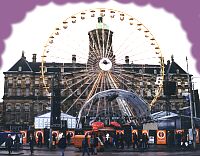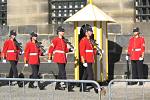|
the facts
From 1639 the City Council starts buying up the necessary houses to build a new and large city hall on the Dam.
Jacob van Campen is the designer and executive architect. City architect
DaniŽl Stalpaert gets the daily management over the construction of this grand City Hall.
In the year 1655 the city hall is official put into service, but the paintings and many decorations still take several decades
to be finished.

In 1795 the Bataafse Republic is proclaimed . . . in practice not more than an amiable
compromising group of national "rulers" of a number of provinces and cities which themselves
have far-reaching powers.
Already more or less a satellite state of France, the Republic becomes completely annexed with France
in 1806 by emperor Napoleon and is also forced to accept his brother Lodewijk Napoleon as king of Holland.
At first the city of Den Haag (The Hague) is chosen as the royal seat, but the Amsterdam City Council has
to hand over her City Hall within two years (slowly but surely, and at first just temporarily) to the new king.
And the Counsil has to move to the Prinsenhof on the Oudezijds Voorburgwal. These moving costs will be at first
paid by the State. The city of Amsterdam herself has to look for new quarters for the state authorities
who are using at the time the building complex Prinsenhof.

Renovations start, mainly from the inside, fortunately without too much demolishing. The occupant will take care for
the maintenance. A balcony appears right across the width on the side of the Dam square.
A number of artworks are moving to the Prinsenhof, others given in custody to two private gentlemen.
But part of that will be soon handed over to the king by force. Among are the paintings
The Night Watch and the Syndics of the Cloth Guild.
The king even forces the town to take down its constantly-in-use Weighhouse on the Dam.
This all happens in spite of all the criticism by the mayor, dignitaries and citizens.

Every other year in August there is a temporary exposition by Dutch artists, where the four best works
are getting a prize. This tradition still exists.

After the fall of Napoleon in 1813, Prince Willem of Oranje gives at first the building back to the city of
Amsterdam, but right after his crowning to king he wants t back.
Because of the bad financial position of Amsterdam it is permitted to the royal family to have
the use of the Citypalace for the time being. The occupant will take care for the maintenance.
From that time on the Citypalace stands most of the time empty.

After World War I it is clear that the building is very neglected and that much overdue maintenance
is necessary on the in- as well as outside.
Amsterdam does not have the finances for a renovation, for moving and for maintaining and
it is decided that the building is not suitable anymore to be used as City Hall.
So it becomes in 1936 state property for a poor compensation of 10 million guilden (even less
then the original construction costs about 250 years ago)
and it is placed at queen Wilhelmina's disposal.
Now the building is official a Palace of the Kingdom and a renovation starts on taxpayers money,
striving for the situation it was in before 1806.
Renamed as Palace on the Dam it is used for years now as a national historic monument to receive and accomodate
official state visitors.
And as a fun-fair for the Orange sprouts,
like their coronations, weddings and stag nights.
|

|



